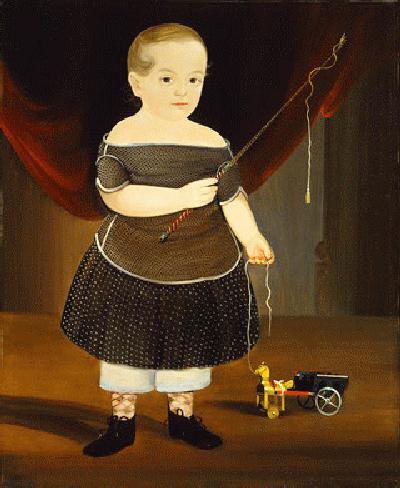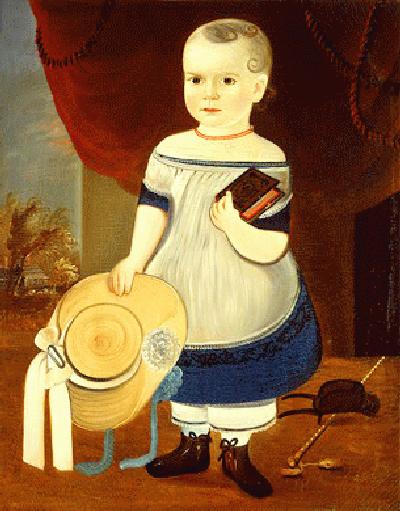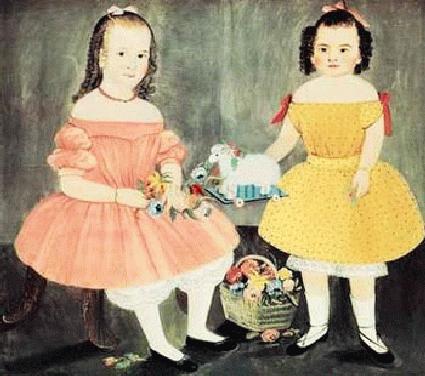
Figure 1.--This work, "Boy with Toy Horse and Wagon", by William Matthew Prior was probably painted around 1845. The boy appears to have a brown pinafore over his dress and plain pantelletes. It is in the collection of the National Portrait Gallery.


Figure 1.--This work, "Boy with Toy Horse and Wagon", by William Matthew Prior was probably painted around 1845. The boy appears to have a brown pinafore over his dress and plain pantelletes. It is in the collection of the National Portrait Gallery. |
American primitive painter William Matthew Prior was born in was born in Bath, Maine in 1806. He is perhaps the most prolific America artist. He advertised his painting skills in the Maine Inquirer in 1827 and 1828. Prior prepared his own canvases, ground his own paints, and with the help of his sons made some of his own frames. The artist
produced some landscapes, but because of public demand, he was primarily a portrait painter. Prior's work is startling in the stlistic variations. His portraits range
from near academic compositions to very primative naive works. He worked at times in close association with Sturtevant J. Hamblin, his brother-in-law. The many portraits provide a very useful view of children's clothes in the early 19th centuty.
William Matthew Prior was the second son of Matthew Prior and Sarah Bryant Prior
of Duxbury, Massachusetts.
Matthew was born in Bath, Maine, in 1806. We have no information on his childhood.
We have no information on Matthew's boyhood clothing.
I do not know if he had any formal art education. His paintings suggest that he did not. He was capable, however, of much more sophisticated paintings than suggested by many of his works. An inscription on one of his paintings suggesta that he may have worked as an appretance in a shop owned by C. Codman in Portland. Charles Codman (1800-1842) was a Portland painter of signs, portraits, land- and seascapes.
Prior began painting in 1823 at the age of 17. His earliest portrait is signed, "W. M. Prior's first portrait 1823". He advertised his painting skills in the Maine Inquirer in 1827 and 1828, offering to paint, broze, gild, varnish, and draw machinery. He also offered to copy paintings, sometimes in glass. He also offered to complete his works in an hour--a useful capability in dealing with children's portraits and explaining his amazing production.

Figure 2.--This work, "Child with Straw Hat,", by William Matthew Prior was probably painted sometime after 1845. We are not sure if the child is aboy or girl. Note the pinafore that the chils wears. The straw hat has a large brim and a flower. The necklace suggests a girl, but small boys also wore them. Note how plain the pantelettes are. The book and riding crop could suggest a boy. I'm not sure about the other object, perhaps a toy. It is in the collection of the National Portrait Gallery. |
Prior married Rosamond Clark Hamblin in 1829. She was from a family of painters. The Priors moved to Portland sometime between 1831 and 1834. They subsequently in 1838 moved to Boston--the major city in New England. Once in Boston Prior at times shared residences with relatives of his wife.
He had sons, but I do not know how many or, for the most part, their identity. He apparently admired Gilbert Stuart because he named one of his sons after him. I am not sure if he ever painted them. Prior was a religious man and was an ardent follower of the Advent Movement. He named one of his daughters, Balona Miller, after William Miller, the founder of the movement's founder. He even wrote two books expressing his adheremce to Miller's teachings: The King's Vesture (1862) and The Empyrean Canopy in 1868. In later life, Prior became a spiritualist. He even claimed he had the ability to see children who had died and could execute their portraits. In this regard he faced no competition from photographic studios. Les Fox informs HBC that West Highland Publishing in 2003 is planning a book on The Children Of William Matthew Prior in 2003. The book includes an article about gender identification in early American folk portraits.
He is perhaps the most prolific America artist. While the other Hamblin brothers earned a living by painting houses and signs, Sturtevant J. Hamblin began painting portraits with his brother-in-law. With their success, Prior moved in 1846 to what he referred to as his "Painting Garret," located at 36 Trenton Street in East Boston. He lived and worked until his death in 1873. He traveled throughout New England, although he once ventured as far south as Baltimore, looking for commissions. Most of his work, however, wwere executed in New England and thus provide a wonferdul glimpse of New England at the time. We are not sure how is career was affected by he increasing popularity and low cost of photography, but by the 1850s and especially the 1860s this must have been a significant factor.
Prior developed skills in many areas, perhaps as a result of an aprreticeship or early efforts to seek commissions. He would prepare his own canvases and ground his own paints. He even made some of the frames he used with the help of his sons.
Prior's work varied greatly from portrait to portrait, making it virtually impossible to identify his portraits from their stlistic attributes. He did do some landscapes. But for the most part what the public wanted, in the years before phogography, was portraits of themselves and their family.
Prior's work is startling in the stlistic variations. His portraits range
from near academic compositions to very primative naive works. Prior explained this in a very business-like way. An advertisement he published indicated: "Persons wishing for a flat picture can have a likeness without shade or shadow at one-quarter price." He obviously had a rigorous system of pricing, depending on a portrait's complexity and academic finish.
Prior was an extremely prolific portrait painter, laeving us with a wonderful record of American children and their clothing in the early 19th century. One interesting observation, given our tendency to think of the 19th century in terms of black and white photograpy, is how colorful these portraits are.
We know that the first image is a boy (figure 1). "Boy with Toy Horse and Wagon", by William Matthew Prior was probably painted around 1845. The boy appears to have a brown pinafore over his dress and plain pantelletes. It is in the collection of the National Portrait Gallery.
"Child with Straw Hat," is more difficult to assess (figure 2). It was probably painted sometime after 1845. We are not sure if the child is aboy or girl. Note the pinafore that the chils wears. The straw hat has a large brim and a flower. The necklace suggests a girl, but small boys also wore them. Note how plain the pantelettes are. The book and riding crop could suggest a boy. I'm not sure about the other object, perhaps a toy. It looks rather like wheel barrow, I'm notvsure what the gender connotations are there, but would guess it would be a boy more than a girl. Notice the similar backdrop to figure 1. I wonder if he brought this back drop with him. The portrait is in the collection of the National Portrait Gallery.

Figure 3.--This Prior painting of the Burnish sisters is useful because it is of two know individuals--the Burnish sisters. Note the ringlet curls and hair bows. I am not sure about the date, but would guess around 1860. |
The Prior painting of the Burnish sisters is useful because it is of two know individuals--the Burnish sisters. Note the ringlet curls and hair bows. I am not sure about the date. They have fancier pantalettes that are higher. One sister has short socks. This suggests the late 1850s or even the 1860s. Notice the symbolic leading strings on the younger girl's dress.
This portrait is entitled "Little child with big dog. The necklace does not identify the
child as a girl; such beads were worn by children of both genders to avert the
croup. On the contrary, the attributes of the child in blue-plumed hat, knife, whip,
the large dog itself-suggest the strength, discipline, mischief, and command of a
boy child."
A HBC reader has provided a description of one of Prior's portraits: At the Terra Museum of American Art is a large portrait of a boy, entitled "Portrait of Young Boy Holding Bow and Arrow with Drum on the Floor", by William Matthew Prior and Sturtevant J. Hamblin. As explained above, Prior worked, in Boston, with several members of the Hamblin family in a studio there). The painting is undated, but Sturtevant Hamblin
was active only in the years 1837-1856 (Prior's dates are 1806-1873, so it is Habmlin's active dates that give the limitation on date for the picture). The boy in the Prior/Hamblin portrait is about 5 years old; he's wearing a kind of dress I've not seen on the HBC site: It is very short-skirted, coming to maybe half-way (or less) between waist and knees with a wide pleated skirt. The top of his dress has white trim and white ruffles
down the low-cut neckline. There is also a bodice of some sort, in white lace, apparently underneath the top of the dress, i.e., the top appears to be fastened over a blouse; however, it's just as likely that the bodice is a piece of the dress, and that the dress was fashioned to look as if it is wrapped over a blouse. The dress was solid green (save for the white trim and, if part of the dress, the faux-bodice). Below, the boy wears very plain
white pantalettes (no ruffles or any other decoration); he wears white stockings and black slipper-like shoes. The Prior/Hamblin painting appears (p. 123 or 124, I've forgotten which) in A Proud Heritage: Two Centuries of American Art, published by the
Terra Museum of American Art, Chicago, 1987. (The painting is listed under the name Prior.)
The HBC reader reports, "Navigating through the links, I notice a photo HBC has is of a boy's dress of about the same length as the one in the Prior/Hamblin portrait. But the similarities end with the length of the dress; the portrait I saw was otherwise quite different (very wide, pleated skirt, solid color with some trim, low-cut ruffled neckline, bodice underneath, unbelted, plain pantalettes)."
We note a Prior potrait brought to the "Antics Road Show" in 2002. It has a child in a bright red dress with relatively shirt hair and a right part. The dress had no collar and a low neckline. The child also had a coral necklace. The reviewer waspositive the child was a boy because he was pictured with a hammar and a board with a nail in it.
Navigate the Boys' Historical Clothing Web Site:
[Return to the Main individual M-R artist alphabetical page]
[Return to the Main American page]
[Return to the Main American primative page]
[Introduction]
[Activities]
[Biographies]
[Chronology]
[Clothing styles]
[Countries]
[Bibliographies]
[Contributions]
[FAQs]
[Glossaries]
[Satellite sites]
[Tools]
[Boys' Clothing Home]
